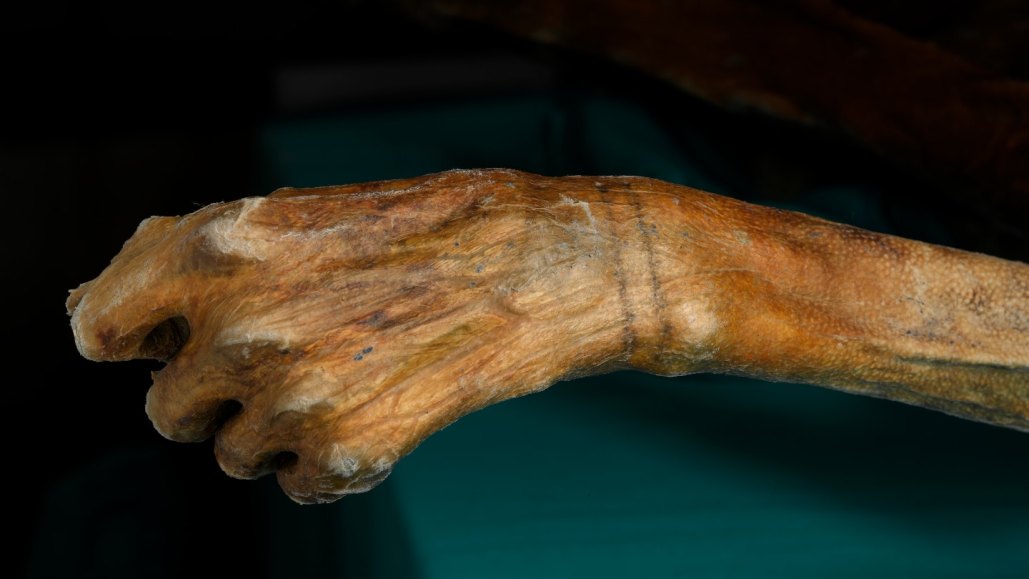The True Origin of Ötzi the Iceman's Tattoos

A recent unconventional experiment has raised questions about a commonly accepted theory regarding Ötzi the Iceman's tattoos.
The approximately 5,200-year-old remains of Ötzi, discovered semi-preserved and naturally mummified in the Italian Alps in 1991, feature 61 tattoos — black lines and crosses on his left wrist, lower legs, lower back and chest. There has been a widely accepted yet untested theory that charcoal ash was embedded into skin incisions made with a sharp stone tool, yielding the oldest known tattoos.
"Our research indicates that the Iceman's tattoos were not made in the way that has been widely assumed for the past thirty years," comments archaeologist Aaron Deter-Wolf, based at the Tennessee Division of Archaeology in Nashville.
The team's experimental tattooing and review of worldwide tattooing practices in traditional societies imply that a handheld, single-point instrument with pigment on its tip punched closely spaced holes into Ötzi's skin. Deter-Wolf and his colleagues assert, in a paper published this March in the European Journal of Archaeology, that this type of "hand-poke" tattooing has been documented since the mid-19th century in preindustrialized cultures worldwide, including where Ötzi resided in central Europe.
In carrying out the research, Deter-Wolf worked with four professional tattooists who focus on traditional, non-electric methods. One of these tattooists, Danny Riday from The Temple Tattoo in Tamahere, New Zealand, assisted by his colleagues, tattooed eight identical line designs on one of his legs using eight tools and four traditional techniques.
The tools, constructed from animal bone, obsidian, copper, a boar tusk and a steel needle, were used in hand poking; tapping a handle attached to a bone point or bone comb with wooden implement to insert pigment-coated points into the skin; cutting the skin with an obsidian blade before pigment was rubbed in; and using a needle to guide a pigment-soaked thread through the skin's outer layer.
Danny Riday, professional tattooist and co-author of the study, volunteered his leg to test various traditional tattooing techniques for the team's investigation into the origins of Otzi's tattoos. The tattoos, as shown here, incorporate techniques and tools such as: tapping a bone point handle, poking with a copper awl, cutting skin with an obsidian blade, and threading pigment-infused line through skin with a bone needle; tapping a boar tuskcomb, poking with a steel needle, poking with a bone point, and poking with obsidian flake.
After the tattoos on Riday’s leg had fully healed after six months, the scientists compared these to UV and high-resolution digital images of Otzi's tattoos.
Distinctive characteristics were evident in the tattoos depending on the tools and techniques used, according to Deter-Wolf. Notably, Ötzi's skin decorations, one to three millimeters in breadth, exhibited traits of being hand poked with a bone point or copper awl, including spot effects, rounded ends and uneven spreading of the pigment.
While the new study cannot definitively resolve how Ötzi's tattoos were made, the researchers present "comprehensive and plausible reasons" supporting the hand poking theory, says Marco Samadelli, in charge of the human remains conservation lab at Eurac Research’s Institute for Mummy Studies in Bolzano, Italy. Samadelli oversaw the preservation of the Iceman artifact from 1998 to 2021.
Deter-Wolf notes a bone awl found among Ötzi’s possessions as well as an antler tip from his quiver, both seen as potential tattooing implements, but these have yet to be inspected for any tattooing-related damage or pigment remnants.




